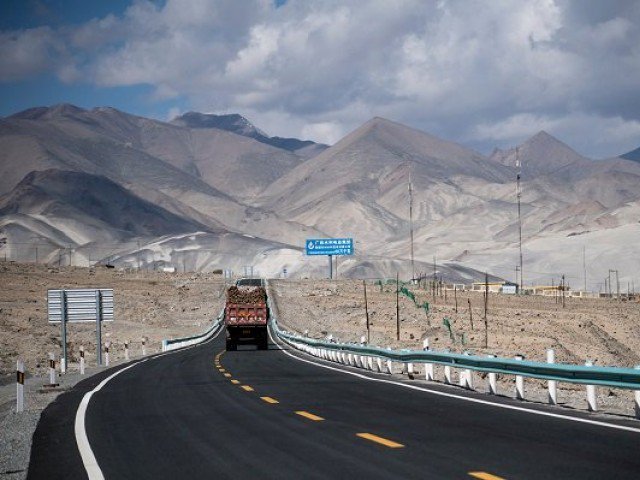The China-Pakistan Economic Corridor (CPEC) is not a debt trap, but rather an endeavor that demonstrates success in multiple facets.
The overarching goals driving its establishment, its funding structure and most significantly, the tangible and constructive outcomes it has produced for both sides all underscore the effectiveness and prosperity of this collaboration program.
The corridor’s inception in 2013 was a response to Pakistan’s dire energy crisis and economic challenges, with China providing crucial support during a critical period.
Its primary objectives are infrastructure development, energy security and connectivity enhancement.

Chinese and Pakistani workers work on the construction of a road at an energy project under the China-Pakistan Economic Corridor in Punjab, Pakistan in June, 2017
Chinese investment and assistance have funded more than 80 percent of the projects under the corridor. The remaining funding comes from concessional loans from the Chinese government.
According to the Chinese Foreign Ministry, in the past ten years, the corridor has brought more than 25 billion U.S. dollars of direct investment to Pakistan.
Notably, more than 510 kilometers of highway have been constructed and approximately 8,000 megawatts of electricity, including clean energy, have been generated within the country.
The investments on various infrastructure projects have significantly enhanced the country’s transportation capacity and alleviated its long-time energy shortages.
Statistics from the World Bank show that Pakistan’s GDP growth increased from 4.4 percent in 2013 to 6.2 percent in 2022 despite the impacts of the COVID-19 pandemic.

Statistics from the World Bank show that Pakistan’s GDP growth increased from 4.4 percent in 2013 to 6.2 percent in 2022
The growth could largely be attributed to the significant investments made under the corridor, which have effectively tackled the obstacles of poor transportation and energy supply that had hindered Pakistan’s economic development for a long time.
Additionally, over the past decade, the corridor has generated over 200,000 jobs, greatly increasing the well-being of the people.
Collaboration across various industries has also bolstered Pakistan’s self-sufficiency and improved the convenience of everyday life for its citizens. An example of this is the availability of motorcycles in the country, facilitated by Chinese technologies and imports of motorcycle parts.
Pakistani ambassador to China Moin ul Haque told me during a recent interview that the CPEC has been a great success in bringing too many economic dividends and prosperity to Pakistan, benefiting people and different industries.

Pakistani ambassador to China Moin ul Haque says that the CPEC has been a great success in bringing economic dividends and prosperity to Pakistan
Building various pieces of infrastructure, contributing to socioeconomic development and creating hundreds of thousands of jobs runs contrary to what a debt trap should look like, as a debt trap most likely happens when the borrower uses the money for non-productive activities that do not enhance production capacity or increase the size of the economy.
One important component of the CPEC is the Gwadar Port located in southwestern Pakistan. The once desolate fishing town has become a vibrant port with various functions.
A free trade zone established at the port has more than 40 Chinese companies and local companies operating there. The businesses cover fields such as overseas warehousing, fertilizers, metal materials manufacturing, agricultural development and tourism.
Investment at the port has exceeded 410 million U.S. dollars, providing nearly 5,000 job opportunities for local residents.

A cargo of 200 tonnes of fish awaits to be shipped to China from the Gwadar Port in southwestern Pakistan
The second phase of the Free Trade Zone was launched in July last year, with an area 36 times larger than the first phase. In the interview, Ambassador Haque told me that the port had become a sea-land-air transportation hub, benefiting other countries in the region.
What’s worth pointing out is that the Gwadar Port is an investment project based on grants, meaning the Pakistani government does not have to repay the investment for port development.
Some might argue that China is a money lender anyway and borrowers need to pay back the money in the end. True but China lends money to Pakistan at one of the lowest interest rates, with the government loan rates related to the CPEC being 2%.
The repayment period is 20 to 25 years and actually the country was able to start its debt repayment in 2021.
The Chinese loan and investments under the CPEC were made primarily for mutual economic and trade cooperation. China is also benefiting in various ways.
Firstly, the roads, highways, port and airport along the corridor will greatly facilitate bilateral trade and cooperation and also with countries in the Middle East, Africa and Europe. For instance, in 2022, Pakistan’s exports of sesame to China increased by 50 percent and rice exports exceeded one million tons, a record high.
Secondly, the corridor provides a good alternative route for China to import oil and gas, reducing import costs, time and risk significantly.
Thirdly, China is not alone in providing loans for other countries that need them. Since the end of World War II, it has been a common practice for countries to implement major projects through international financing.
According to data from the Pakistani Ministry of Economic Affairs, as of the first quarter of this year, loans from China accounted for 16 percent of the country’s total external debt.
The remaining comes from other countries and international institutions. At the end of the interview, Ambassador Haque told me that China and Pakistan are upgrading cooperation along the corridor, focusing on industrialization, agricultural modernization, and digitization.
This upgrading will lead to broader cooperation prospects and higher revenues, further boosting Pakistan’s economy and enhancing its ability to repay debt.
With the further development of the corridor, Pakistan will not fall into a debt trap but rather continue benefiting enormously from the China-aided project. Over time, it will also play a more prominent role in the development and stability of the region and beyond.
















